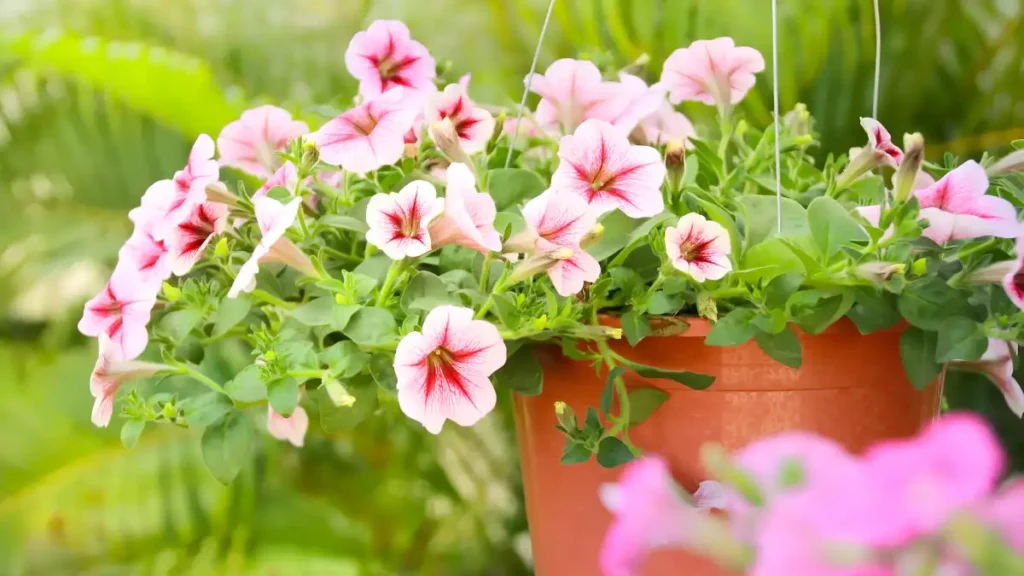Petunias are a popular option for hanging baskets and containers because of their vivid colors, profusion of flowers, and ease of maintenance. Various types of petunias are available, each with special qualities to suit different garden environments. The most popular types are Wave petunias, which are perfect for spilling over the sides of containers; Multiflora, which has smaller, more frequent blooms; and Grandiflora, which is recognized for its huge, beautiful flowers. The beauty and fullness of hanging baskets or container gardens can be enhanced by selecting the correct kind of petunia, creating a striking display that lasts throughout the growing season.
Here are several types of petunias for hanging baskets:
1. Supertunia series
- Growth Pattern: Mounding or trailing
- Features of the Bloom: Big, vibrant blooms
- Best Features: Deadheading (removing wasted blooms) is not necessary for supertunias because they are robust bloomers. They are heat-tolerant and available in a broad range of colors.
- Perfect for: Hanging pots and baskets that have room to overflow the edges.
2. Wave petunias
- Growth Pattern: Enveloping and enveloping
- Features of the Bloom: Medium-sized blossoms
- Best Features: Wave petunias are perfect for large containers or hanging baskets because of their propensity to spread and fill up gaps. They require little care and do well in both heat and humidity.
- Perfect for: Dense, cascading effects in large baskets or mixed containers.
3. Easy wave petunias
- Growth Pattern: Mounding and spreading
- Features of the Bloom: Medium-sized blooms
- Best Features: Less aggressive, more regulated spreading tendency; similar to Wave petunias. They offer a thick, uniform layer of blooms.
- Perfect For: Hanging baskets and containers that favor a regular, tidy growth pattern.

4. Double petunias
- Growth Pattern: Tight to Enduring
- Features of the bloom: large, ruffled, double-layered blooms
- Best Features: Double petunias provide a fuller, more elegant-looking flower head. They look their best in hanging baskets or other containers that showcase their striking blossoms.
- Perfect For: Since their blossoms might be more delicate than those of single-flowered species, hanging baskets and patio containers that are situated in protected settings are the best options.
5. Calibrachoa (Million Bells)
- Growth Pattern: Trailing
- Features of the bloom: Tiny, bell-shaped blossoms
- Best Features: Although Calibrachoa are not actual petunias, they are frequently mistaken for them due to their similar appearance. They constantly bloom, are incredibly resilient, and clean themselves.
- Perfect For: Tiny containers and hanging baskets where a delicate trailing effect is desired.
6. Cascadia petunias
- Growth Pattern: Trailing
- Features of the bloom: Abundant flowers in a wide range of colors
- Best Features: Cascadia petunias have a soft, flowing habit and produce a lot of flowers. They are self-cleaning, so they continue to look good without much maintenance.
- Perfect For: Hanging baskets and window boxes where you want a delicate cascading look.
7. Tidal wave petunias
- Growth Pattern: Mounding and spreading
- Features of the Bloom: Huge blooms
- Best Features Petunia tidal waves are incredibly powerful and can expand to a height of four feet. They work great as ground cover or for containers with lots of coverage.
- Perfect For: Robust, trailing growth, and extra-large containers or baskets.
Advice for growing petunias in containers:
- For the finest flowers, petunias require six to eight hours of full sun every day.
- While regular watering is crucial, make sure there is adequate drainage to avoid root rot.
- Every few weeks, apply a balanced fertilizer to promote ongoing blooming.
- Even while many contemporary kinds clean themselves, older varieties may produce more flowers if spent blooms are removed.

Conclusion:
Throughout the growing season, you can use these types of petunias to spruce up your hanging baskets and containers with brilliant color and abundant flowers. When making your choice, take into account the container’s size, the local climate, and the level of upkeep you’re prepared to provide it.
Certainly! If you’d like to learn more, please consider following our WhatsApp Channel: Harvest Gardening
A frequently asked questions:
Q1: What types of petunias don’t need deadheading?
A1: Supertunias and Wave petunias are two types of petunias that don’t need to be deadheaded since they will drop their wasted flowers on their own and keep blooming without any care.
Q2: What is the difference between trailing petunias and petunias?
A2: Trailing petunias are perfect for hanging baskets or ground cover since they grow outward and cascade, commonly referred to as “spreading” or “wave” petunias. Regular petunias have less spreading growth and tend to grow more erect or bushy.
Q3: How many types of petunias are there?
A3: There are about 35 different types of petunias, and they are often divided into four categories: groundcover (also called spreading or wave petunias), grandiflora, multiflora, and milliflora. The size, growth habits, and flowering patterns of each variety differ.
Q4: Do petunias grow better in pots or the ground?
A4: Although they grow well in the ground as well as in pots, petunias prefer the controlled conditions of soil drainage and sunshine exposure in pots. For best development, they require full sun and well-drained soil when planted in the ground.



